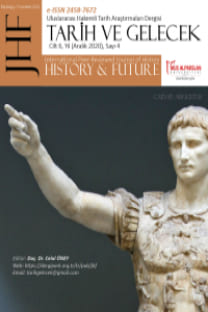Tapınak Şövalyeleri’nin Yol Haritası: 1129 Tarihli Tüzük ve Düşündürdükleri
Haçlı Seferleri, Tapınak Şövalyeleri, Troyes Konsili, İlk Tüzük
The Knights Templar’s Roadmap: The 1129 Statute and its Considerations
___
- Addison, Charles G., The History of Knights Templars: The Temple Church And The Temple, Printed by G. J. Palmer, Savoy Street, London 1842.
- Albert of Aachen, Historia Jerosolimitona: History of the Journey to Jerusalem, Edited and Translated by Susan B. Edigington, Clarendon Press, Oxford, 2007.
- Asbridge, Thomas, Haçlı Seferleri, (Çev: Ekin Duru), Say Yayınları, İstanbul 2014.
- Augustinus, İtiraflar, Çev: Dominik Pamir, Kaknüs Yayınları, İstanbul 1999.
- Barber, Malcolm, Yeni Şövalyelik; Tapınak Tarikatının Tarihi, (Çev., Berna Ülner), Kabalcı Yayınevi, İstanbul, 2006.
- Bernard de Clairvaux, Êloge de la Nouvelle Chevalerie: Vie de Saint Malachie Êpitaphe, Hymene, Lettres, İntroductions, Traductions, Notes et İndex Par, Pierre-Yves Emery, ouvrage Publiê le concours du Centre National Lettres ed de la Delegation Gênêrale â la Langue Française, Paris, 1990.
- Boas, Adrian J., Jerusalem İn The Time Of The Crusades: Society, Landscape And Art İn The Holy City Under Frankish Rule, Published by Routledge, London 2001.
- Burgtorf, Jochen, The Centrol Convent of Hospitallers and Templers History, Organization and Personnel (1099/1120-1310) Brill Publishing, Baston, 2008.
- Burman, Edward, The Templars: Knights of God, Destiny Books, printed and bound in the United States, 1986. Campbell, G. A., The Knights Templars: Their Rise and Fall, River Press, London, 1937
- Carnotenses, Fulcherius, Kudüs Seferi, Çev: İlcan Bihter Barlas, IQ Kültür Sanat Yayınları, İstanbul 2009.
- The Confession of St. Augustine, Translated by j. G. Pilkington, İnternational Collectors Library, New York, 2004.
- Curzon, Henri De, La Regle Du Temple, Publıee Pour La Socıete De L’hıstoıre De France, Paris 1886.
- Çeken, Muhittin, Tapınak Şövalyeleri (Kuruluşu, Yükselişi, Kurumsal Yapısı ve Düşüşü), (Basılmamış Doktora Tezi), Manisa, Celal Bayar Üniversitesi Sosyal Bilimler Enstitüsü, Manisa, 2018
- Eco, Umberto, Ortaçağ: Katedraller-Şövalyeler-Şehirler, Çev: Leyla Tonguç Basmacı, Alfa Yayınları, İstanbul 2014.
- Fuller, Thomas, The Historie Of The Holy Warre, Colledge in Cambridge, Cambrdige 1640.
- Jacques de Vitry’s, History of Jerusalem, Translated From The Original Latin By Aubrey Stewart, Palestine Pilgrims Text Society, London 1896.
- Read, Piers Paul, Tapınak Şövalyeleri, Dost Kitabevi Yayınları, Ankara, 2003.
- Relation Des Voyages De Saewulf: A Jerusalem Et En Terre-Sainte, Publiee Pour La Premiere Fois, Paris, 1839.
- The Rule of Our Most Holy Father St. Benedict, Edited in Latin and English By One of The Benedictine Fathers of St. Michael’s, R. Wahsbourne, 18 Paternoster Row, London 1875.
- The Rule of St. Benedict in English, Editor Timothy Fry, The Liturgical Press, Collegeville, Minnesota, 1982.
- The Rule of The Templars: The French Text of The Rule of The Order of The Knights Templaer, Translated and İntroduced by J. M. Upton-Ward, Studies in The History of Medieval Religion, V. 6, Boydell Press, USA 1992.
- The Rule of St. Benedict, Translated by W. K. Lowther Clarke, London 1931. Runciman, Steven, Haçlı Seferleri Tarihi, Cilt: 2, (Çev., Fikret Işıltan), Türk Tarih Kurumu Yayınları, Ankara, 2008.
- Stebbing, Henry, The History of Chilvary and the Crusades, Vol. 2, Printed For Constanble and Co., Edinburgh, 1830.
- The Syriac Chronicle of Michael Rabo (The Great): A Universal History From The Creation, Translation and İntroduction by Matti Moosa, Beth Antioch Press, USA 2014.
- Torsello, Marino Sanudo, The Book of the Secrets of the Faithfull of the Cross: Liber Secretorum Fidelium Crucis, Translated by Peter Lock, Crusade Text in Translation 21, Routledge Taylor&Francis Group, Loondon and New York, 2016. Wasserman, James, The Templars And The Assasins: The Milita of Heaven, Translated by Lisa Coffin, İnner Traditions, Rochester, Vermont 2001.
- William of Tyre, A History of Deeds Done Beyond The Sea, Translated and Annotated by Emily Atwater Babcock and A.C. Krey, Volume One, Columbia University Press, New York, 1943.
- Wojtowicz, Robert T., The Original Rule of the Knights Templar: A Translation with İntroduction, Unpublished Degree of Master of Art Thesis, Western Michigan University Kalamazoo, Michigan, 1991.
- Yayın Aralığı: Yılda 4 Sayı
- Başlangıç: 2015
- Yayıncı: Celal ÖNEY
XIX. Yüzyılın Başından XX. Yüzyılın Başlarına Arap Coğrafyasında Mevlevihaneler
II. Meşrutiyet Dönemi’nde Bitlis Vilayeti’nde Karayolları
Safevi Devleti Kurulmadan Önce Erdebil Dergâhı Şeyhlerinin Siyasi Faaliyetleri
Eski Türklerde Güneş Algısı Ve Atatürk’ün Güneş Olarak Sembolize Edilmesi
Sivas Sancağının Sürgün Müftüleri
Çariçe Katerina’nın Rus Kadın Eğitimine Sağladığı Bir Katkı -Smolniy Enstitüsü (1764-1919)
Murat HANİLÇE, Turan İBRAHİMZADE
17. Yüzyılın İkinci Yarısında Edirne'de Gayrimüslimlerin İktisadi Faaliyetleri
